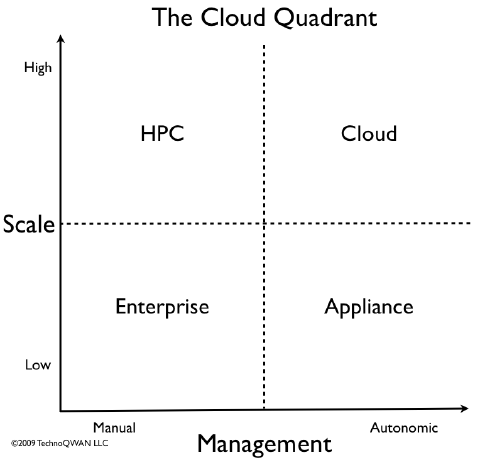The Cloud Quadrant
Thinking about cloud
Amid the hype and glitz on cloud storage and computing it can be difficult to separate the essential from the transitory. The word scale is abused; APIs are debated; business models are in flux: and new varieties of cloud infrastructure are being developed or marketed every month.
To get a handle on the concept I've developed a descriptive model that may help move the conversation forward.
The essential elements of cloud are scale and management. Everything else is negotiable – including cost.
Putting those on the axes of a graph gives a simple visual picture of the scale and management environment.
Scale is reasonably self-explanatory: single namespace; single management domain; reasonable upward performance increment per incremental dollar investment.
Management is perhaps more complex. Researchers at IBM have long championed the idea of autonomic — self managing — systems. At the highest level cloud systems require an autonomic management paradigm: there's just too much gear and too many failures for people to fix. The infrastructure must be self healing, load balancing, and fault and disaster tolerant.
These are qualitative not quantitative metrics. However it is worth exploring why the other quadrants are named as they are.
- Appliance. This quadrant shares many of the same self management capabilities of the cloud but on a smaller scale. Today we see these systems popular with large volume imaging applications in medical and media production.
- Enterprise. Enterprises don't have the luxury of a few primary application types. They need systems that adapt to a wide variety of legacy application requirements. In addition they face considerable regulatory and legal constraints that make tuning the storage infrastructure imperative.
- High-Performance Computing. HPC systems need to be highly tunable to meet specialized application requirements. When an application takes days or weeks to run even on few extra percentage points of performance out of the system translates into hours or days saved.
Vendors on the quad
In the second chart I've made a first-order approximation of where various systems set on the cloud quadrant. These positions are not cast in concrete or even, at this point, Jell-O. Nor should readers assume that any quadrant is superior to any other in a marketing or technical sense.
I ask readers and vendors for their help in creating a more comprehensive cloud quadrant. There are vendors that I know I left out and other vendors who may feel that they are scalability or management capabilities are wrongly estimated.
I expect to do more work on this in the weeks ahead. It may prove helpful in sorting out some of the currently not well differentiated scalable storage and compute markets.
The StorageMojo take
There is no doubt that Internet-based storage and computing represents a major paradigm shift, not unlike that of PC networks in the 80s and client server computing. In all of these shifts the imagined long-term benefits have far outweighed the immediate and very real costs.
But cloud computing is different: it is the first pay-as-you-go infrastructure. Every user can look at the price tag and make an economic decision based on real costs. In the 80s it took years for good data on the costs and benefits of PC networks to emerge. Good thing too, since CFOs would have screamed.
Tens of thousands of companies and individuals are adopting cloud today based on benefits they see and costs they pay. Yes, there is much hype around cloud computing. But the customers are voting with their dollars and that tells us there is a real economic advantage in cloud computing as well.
Courteous comments welcome, of course.
Related posts:
- Cloud storage is a component The cloud
- Private clouds won't fly Massive ec
- Clouds over Berkeley: the RADLab reviews cloud computing pt. 1 Cloud comp
- Cloud, sand and scale And commer
- Clouds over Berkeley: the RADLab reviews cloud computing pt. 2 In our las

